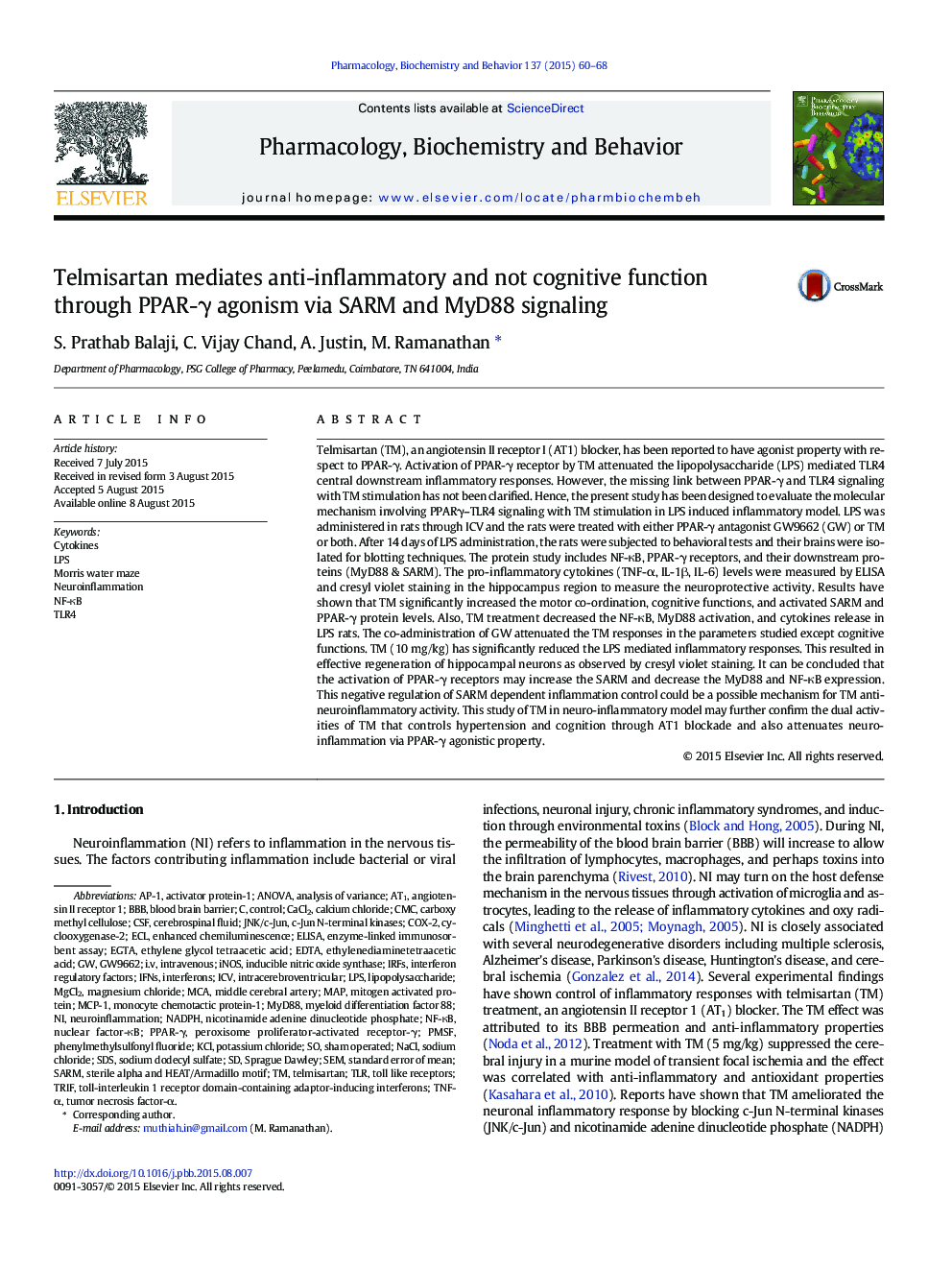| کد مقاله | کد نشریه | سال انتشار | مقاله انگلیسی | نسخه تمام متن |
|---|---|---|---|---|
| 2012762 | 1541847 | 2015 | 9 صفحه PDF | دانلود رایگان |
عنوان انگلیسی مقاله ISI
Telmisartan mediates anti-inflammatory and not cognitive function through PPAR-γ agonism via SARM and MyD88 signaling
دانلود مقاله + سفارش ترجمه
دانلود مقاله ISI انگلیسی
رایگان برای ایرانیان
کلمات کلیدی
AP-1MYD88NADPHEGTACOX-2iNOSMCP-1ECLICVintracerebroventricularPMSFTLRAT1SARMTLR4GW9662JNK/c-JunIRFsAngiotensin II receptor 1i.vMgCl2SDSCMCLPSMCAKClCaCl2NaClNF-κBPPAR-γc-Jun N-terminal kinases - C-Jun N-terminal kinasesIFNs - IFN هاMitogen activated protein - Mitogen فعال پروتئینTRIF - Trif بهEDTA - اتیلن دی آمین تترا استیک اسید ethylene glycol tetraacetic acid - اتیلن گلیکول تتراستیک اسیدEthylenediaminetetraacetic acid - اتیلینیدامین تتراستیک اسیدSprague Dawley - اسپراگ داولیNeuroinflammation - التهاب عصبیinterferons - اینترفرون هاenhanced chemiluminescence - بهبود شیمیایی لومنanalysis of variance - تحلیل واریانسANOVA - تحلیل واریانس Analysis of varianceELISA - تست الیزاEnzyme-linked immunosorbent assay - تست الیزاTelmisartan - تلمیزارتانtumor necrosis factor-α - تومور نکروز عامل αstandard error of mean - خطای استاندارد میانگینIntravenous - داخل وریدیBBB - سد خونی مغزیblood brain barrier - سد خونی مغزیsodium dodecyl sulfate - سدیم دودسیل سولفاتSodium chloride - سدیم کلریدinducible nitric oxide synthase - سنتاز اکسید نیتریک القاییCytokines - سیتوکین هاCyclooxygenase-2 - سیکلوکوکسیژناز2sham operated - شام کار کردmiddle cerebral artery - شریان مغزی میانیmyeloid differentiation factor 88 - عامل تمایز میلوئید 88interferon regulatory factors - عوامل تنظیمکننده اینترفرونTNF-α - فاکتور نکروز توموری آلفاnuclear factor-κB - فاکتور هسته ای κBphenylmethylsulfonyl fluoride - فنیل متیل سولفونیل فلورایدlipopolysaccharide - لیپوپلی ساکاریدMorris water maze - ماز آب آب موریسToll like receptors - مانند گیرنده هاCSF - مایع مغزی نخاعیCerebrospinal fluid - مایع مغزی نخاعیSEM - مدل معادلات ساختاری / میکروسکوپ الکترونی روبشیmap - نقشهnicotinamide adenine dinucleotide phosphate - نیکوتین آمید adenine dinucleotide phosphateMonocyte chemotactic protein-1 - پروتئین chemotactic monocyte-1activator protein-1 - پروتئین فعال کننده-1carboxy methyl cellulose - کربوکسی متیل سلولزMagnesium chloride - کلرید منیزیمPotassium chloride - کلرید پتاسیمCalcium chloride - کلسیم کلریدControl - کنترلPeroxisome proliferator-activated receptor-γ - گیرنده پروتئینی فعال پروکسیوم - γ
موضوعات مرتبط
علوم زیستی و بیوفناوری
بیوشیمی، ژنتیک و زیست شناسی مولکولی
زیست شیمی
پیش نمایش صفحه اول مقاله

چکیده انگلیسی
Telmisartan (TM), an angiotensin II receptor I (AT1) blocker, has been reported to have agonist property with respect to PPAR-γ. Activation of PPAR-γ receptor by TM attenuated the lipopolysaccharide (LPS) mediated TLR4 central downstream inflammatory responses. However, the missing link between PPAR-γ and TLR4 signaling with TM stimulation has not been clarified. Hence, the present study has been designed to evaluate the molecular mechanism involving PPARγ-TLR4 signaling with TM stimulation in LPS induced inflammatory model. LPS was administered in rats through ICV and the rats were treated with either PPAR-γ antagonist GW9662 (GW) or TM or both. After 14 days of LPS administration, the rats were subjected to behavioral tests and their brains were isolated for blotting techniques. The protein study includes NF-κB, PPAR-γ receptors, and their downstream proteins (MyD88 & SARM). The pro-inflammatory cytokines (TNF-α, IL-1β, IL-6) levels were measured by ELISA and cresyl violet staining in the hippocampus region to measure the neuroprotective activity. Results have shown that TM significantly increased the motor co-ordination, cognitive functions, and activated SARM and PPAR-γ protein levels. Also, TM treatment decreased the NF-κB, MyD88 activation, and cytokines release in LPS rats. The co-administration of GW attenuated the TM responses in the parameters studied except cognitive functions. TM (10 mg/kg) has significantly reduced the LPS mediated inflammatory responses. This resulted in effective regeneration of hippocampal neurons as observed by cresyl violet staining. It can be concluded that the activation of PPAR-γ receptors may increase the SARM and decrease the MyD88 and NF-κB expression. This negative regulation of SARM dependent inflammation control could be a possible mechanism for TM anti-neuroinflammatory activity. This study of TM in neuro-inflammatory model may further confirm the dual activities of TM that controls hypertension and cognition through AT1 blockade and also attenuates neuro-inflammation via PPAR-γ agonistic property.
ناشر
Database: Elsevier - ScienceDirect (ساینس دایرکت)
Journal: Pharmacology Biochemistry and Behavior - Volume 137, October 2015, Pages 60-68
Journal: Pharmacology Biochemistry and Behavior - Volume 137, October 2015, Pages 60-68
نویسندگان
S. Prathab Balaji, C. Vijay Chand, A. Justin, M. Ramanathan,